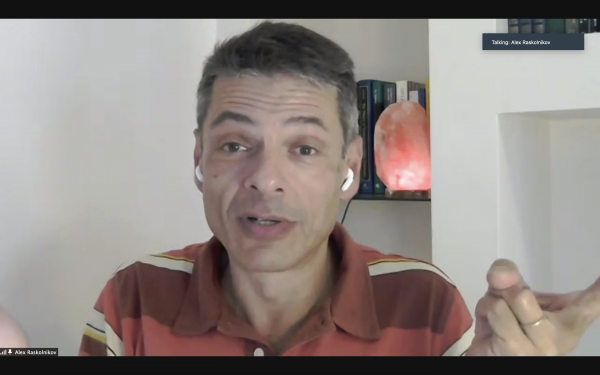Zooming to the Next Level in Remote Teaching
The novelty has worn off, but Law School faculty have learned ways to enhance their teaching with remote learning tools.

In the first weeks of the COVID-19 pandemic, Columbia Law School faculty members approached teaching via Zoom with some uncertainty and a range of familiarity with—and interest in—remote learning technology. Now, as a third semester of remote and hybrid instruction comes into view and with more class hours behind them, faculty members say they are using remote teaching tools in new ways to foster a course experience where everyone is engaged and on the same page. And in contrast to the first months of using Zoom, some now believe there are aspects of online learning worth continuing in the post-pandemic classroom.
"One of the benefits of online teaching has been access to excellent guest speakers, many of whom could not have traveled to New York to speak but were happy to join a Zoom class." —Professor Anu Bradford
James S. Liebman
Simon H. Rifkind Professor of Law
Teaching Structural Change in Public Education Policy and Social Change Lab
If you went to faculty now with the question not of “how are you coping?” but “what have you learned about your own teaching and about what you would want to do going forward?” I think you would find that even people who find the distance modality to be uncomfortable would still identify a lot of things they’ve gained. What I was able to do last spring was survive. I didn’t hit my stride until this semester. Now I’m puzzling over the possibility I may be a better teacher online than in the classroom.
In a Zoom class you might worry that you have less control because you’re not in person, but in fact, there are ways you have more control. I can see everybody’s face—right up close if I want to. And I have a much better sense about what students are actually doing at that moment. We run the chat at the same time we run the class. I know that seems crazy, but it actually doubles the amount of classroom participation: There’s a conversation going on in the chat among the students, there’s a conversation going on in the class, and with the help of the TAs, we bring them together. That, in turn, increases the amount of conversation in class by warming up the students and getting them thinking about things that then they’re willing to share.
If you’re in a big room at Jerome Greene Hall, it’s very hard to do small groups because the chairs are fixed in place. A few seminar rooms have tables and chairs on wheels, but Zoom gives you the chance to be even more instantly mobile. With students working in groups on Google documents everyone can see, I’m able to watch all groups work at once, and we can all immediately, jointly debrief when they’re finished. The students get good at doing this in short 5- to 7-minute chunks, meaning we get a lot of collaborative work done quickly. And I’m still only scratching the surface of what’s possible.
Katherine M. Franke
James L. Dohr Professor of Law
Teaching Racial Justice Advocacy Workshop; Columbia Law School and Slavery (seminar)
I taught two hybrid classes this fall and concluded that the added value of my being in the classroom in addition to the Zoom sessions wasn’t really worth it. There’s a surprisingly wonderful intimacy that comes with being on Zoom together, yet when I’m in the classroom with my mask on I lose that intimacy. I’ve also developed new teaching methods that distribute responsibility for how we discuss the issues in the course to a group of students in each class. I also have much more contact with students outside of class time and feel that I’ve gotten to know them much better than in years past. I do miss the energy that is generated when we’re all physically present in the room, but I’ve found other ways to make the learning experience dynamic.
David M. Schizer
Dean Emeritus and Harvey R. Miller Professor of Law
Teaching Federal Income Taxation
I teach Socratically. Usually, I pose a series of questions verbally, but I have found that online it works better to provide students with at least some of these questions in advance. So I now offer multipage problem sheets, which take students through the material. The students take turns answering the questions—and, of course, I ask follow-up questions. I think this change has been so successful that I plan to keep using it when the pandemic is over and we are all back in the classroom together.
I also have suggested two different ways for students to raise their hands. Typing “question” in the chat means, “I didn’t understand (or hear) what you said—can I please ask for clarification now?” Raising the blue hand means, “I have a thought or comment that I would like to share or a question about the idea we are discussing.” When we are in person, this is less necessary because I usually can read the room and tell when someone isn’t quite following something. This system ensures that I have the same information online, so we don’t keep going if some students aren’t following—but we can then hold the other questions and comments until a break in the discussion.
Justin McCrary
Paul J. Evanson Professor of Law
Teaching Antitrust and Trade Regulation; Litigation, Economics, and Statistics (seminar)
I find that over Zoom I can do most of what I would normally do in the classroom, and that in some ways, Zoom is better than the classroom experience. What Zoom misses is the connection that we get from physical proximity. But Zoom is better than the classroom in terms of (a) managing queues of people with questions, (b) managing small workgroups, and (c) seeing non-verbal feedback. I use breakout rooms on Zoom. My TAs call on students in a queue, like I do in the classroom, but on Zoom the process of managing student questions is much more orderly because of the blue hand.
Alex Raskolnikov
Wilbur H. Friedman Professor of Tax Law
Teaching Taxation of Financial Instruments
I stumbled into one thing this semester that turned out to be very nice. Typically (before COVID-19) after class is over, a few students would come up to me with some follow-up questions—I think this is very common in many courses—and a few more students would stick around just to listen to the conversation. What I stumbled into is replicating this on Zoom: When the time is up, I say that the class is over and then stick around. Students who have questions turn on their cameras, and we have a little chat. And there are always 10 to 12 students who stick around to listen to me answering these after-class questions. It’s kind of a relaxed atmosphere, there is no rush, and it reinforces the overall tone that I am trying and hoping to set, which is this: While Zoom classes are surely not ideal, it is entirely possible to learn and to have fun even on Zoom.
I also started noticing that a few of my students have festive holiday lights up in their work areas. It brightens the mood. Not to be outdone, I told them that I have my own festive thing, and that I would put it up, but they should tell me if it’s distracting. They loved it. It’s pretty groovy too—a color-changing Himalayan salt lamp. My then-8-year-old son loved it; I got it for him as a gift a few years ago, and then, of course, he lost interest.
Anu Bradford
Henry L. Moses Professor of Law and International Organization
Teaching Comparative and International Antitrust; European Union Law and Institutions; Comparative and International Law Workshop (seminar)
I have been positively surprised by how engaging and rigorous our Zoom conversations have been this semester. Students log on always on time, fully prepared, and eager to engage with the material. When planning for the semester, my goal was to replicate the intellectual energy and the rigor of the classroom experience while ensuring that I create a space for more intimate conversations among smaller groups of students. I was debating whether to abandon my fast-paced Socratic teaching style, which I had not tested before in the online environment. In the end, I chose to give it a try. Seeing how terrific the student engagement was, I have remained committed to the method while making sure that I mix the Socratic dialogue with breakout room discussions, student presentations, and interesting guest speakers. One of the benefits of online teaching has been access to excellent guest speakers, many of whom could not have traveled to New York to speak but were happy to join a Zoom class.
I have an ideal class size for online Socratic teaching as we all fit into the gallery view, making it easier to imagine that we are all sharing the same classroom space. What I miss most from normal times are those informal conversations that I have with students after the class or when I run into them on campus. We have tried to replicate those conversations through virtual coffee chats in small groups.
I have always been deeply impressed with our students but all the more so now. These have been challenging times, but our students’ resilience and commitment to the academic enterprise has been heartening. I will always look back to 2020 with a sense of optimism, taking great comfort in the ability of individuals and institutions to adapt and thrive in the midst of a transformational change and unprecedented challenges.






